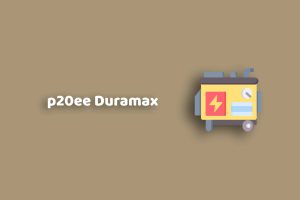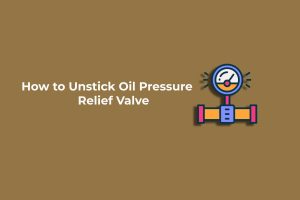Imagine driving your diesel-powered truck when suddenly, the check engine light pops up, accompanied by a diagnostic trouble code—P20EE. You might wonder: What does this mean? Will it affect my vehicle’s performance?
Let’s understand what P20EE means.
What is P20EE Duramax?
The P20EE code in Duramax engines is an OBD-II diagnostic trouble code (DTC) that signals a problem with the Selective Catalytic Reduction (SCR) system. Specifically, it means that the SCR NOx catalyst efficiency is below the threshold on Bank 1—which is your truck’s way of saying, “Hey, I’m not reducing emissions properly!”
Duramax engines, like the LML, L5P, and LGH, rely on the SCR system to reduce nitrogen oxide (NOx) emissions using Diesel Exhaust Fluid (DEF). When the system isn’t working efficiently, the P20EE code appears, often alongside reduced performance or limp mode activation.
Duramax Engine Overview
The Duramax engine series was born in 2001 through a GM-Isuzu partnership, bringing power, efficiency, and reliability to diesel trucks. The first 6.6L LB7 packed 300 HP and 520 lb-ft of torque, setting the standard for performance.
Over the years, models like the LBZ and LML improved fuel efficiency and emissions control. In 2011, the LML introduced Diesel Particulate Filters (DPF) and Selective Catalytic Reduction (SCR) to meet tougher emission standards.
Duramax remains a top choice for towing, hauling, and long drives, thanks to its strength, longevity, and efficiency.
Also Read: Maintaining a Vehicle’s Fuel System: Understanding the P0087 Code on Duramax
Duramax Engine Emission Control Systems
Selective Catalytic Reduction (SCR)
SCR is essential to modern Duramax engines in order to meet strict pollution regulations. Through a chemical reaction aided by a catalyst, SCR is an active emissions control technique that lowers nitrogen oxide (NOx) emissions.
Diesel Exhaust Fluid (DEF)
DEF is a blend of urea and water, and is used by the SCR system to help lower NOx emissions. DEF is broken down into ammonia when it is fed into the exhaust stream. This ammonia then interacts with NOx over the SCR catalyst to produce water and nitrogen, which are both innocuous.
By reducing NOx emissions by up to 90%, this procedure helps cars meet environmental standards set by the government.
Although these pollution control systems greatly lower hazardous emissions, they may also have an effect on fuel economy and vehicle performance. They are nevertheless essential for fulfilling environmental regulations without sacrificing power.
Deciphering the P20EE Code
The P20EE code is activated when the engine control module (ECM) determines that the SCR catalyst is not successfully lowering NOx emissions. The code specifically shows that the SCR catalyst is not operating efficiently because the NOx levels downstream of the catalyst are greater than permitted.
The P20EE code can result from a number of factors:
- Poor DEF quality: The code may be activated if DEF that is of poor quality or polluted is unable to effectively reduce NOx emissions.
- SCR system inefficiency: As a result of wear, corrosion, or contamination, the SCR catalyst may eventually lose some of its effectiveness and drop below its efficiency threshold.
Symptoms of the P20EE Code
The most visible sign that there is a problem with the engine or emissions system is the check engine light.
Here are some symptoms that would appear when a Duramax engine’s P20EE code is activated:
- DEF system alerts: The car may also show DEF system-related alerts, which could point to possible problems with the amount or quality of DEF.
- Decreased fuel economy: When the engine strains to operate within pollution limitations, a faulty SCR system might result in decreased fuel economy.
- Performance problems: Common symptoms include slow acceleration, low power, or a general decline in engine performance.
- Limp mode activation: The car may occasionally go into limp mode, a safety measure that reduces engine output to stop additional harm.
- Problems with emissions compliance: A broken SCR system may result in higher NOx emissions, which could lead to the car failing emissions testing.
It is important to pay attention to these symptoms since they may impact your car’s functionality and legal compliance.
Also Read: Decoding GM Fuel Pump Wire Color Codes
Diagnosing the P20EE Code
P20EE code diagnosis in a Duramax engine calls for specialised equipment and a methodical methodology. The two most widely used diagnostic instruments are:
- OBD-II Scanner: This tool is used to look for stored data on the car’s computer and recover diagnostic issue codes.
- Multimeter: A multimeter is used to diagnose sensor operation, including checking the NOx sensors, and to verify electrical values.
Use these procedures to diagnose the P20EE code:
- Connect OBD-II scanner: To obtain any error codes, including P20EE, insert the scanner into the car’s OBD-II port.
- Examine the quality of DEF: Make sure the DEF tank is contaminated-free and filled with premium fluid.
- Examine the NOx sensors: Make sure the NOx sensors are operating correctly by testing them with a multimeter.
- Examine the catalyst for SCRs: Look for indications of damage, contamination, or blockage in the SCR catalyst.
DIY diagnosis is feasible, but for a more thorough analysis of the SCR system, a professional inspection could be necessary.
Also Read: What Is Duramax P0380?
P20EE Code Fixes and Restorations
Depending on what’s causing the problem, there are a few possible fixes if your Duramax engine causes the P20EE code to appear:
- Clean or replace the NOx sensors: If the sensors are malfunctioning, they ought to be changed.
- Replace the SCR catalyst: The catalyst may require cleaning or replacement if it isn’t working properly. This can be an expensive fix, depending on how serious the problem is.
- Make use of superior DEF: To avoid contamination problems, always make sure you’re utilising DEF that complies with ISO 22241 requirements.
- Frequent upkeep: The P20EE code can be avoided by performing routine maintenance and inspections on the DEF system and SCR components.
Preventive Actions
Take the following precautions to keep the P20EE code from being triggered in the future:
- Use high-quality DEF: To guarantee efficient NOx reduction, always use DEF that satisfies ISO requirements.
- Conduct routine inspections: Check for wear or contamination on a regular basis in the NOx sensors, SCR catalyst, and DEF system.
- Keep abreast on software updates: To guarantee the best SCR system performance, make sure your engine control module (ECM) has the most recent software updates.
- Regular Auto Repair: Observe the suggested maintenance schedule provided by the manufacturer, which includes checking the emissions system, changing the oil, and replacing the filter.
You can maintain your Duramax engine’s performance and emissions compliance while also extending its lifespan by being proactive.
Keep Your Duramax Running Strong
In conclusion, the P20EE code in Duramax engines is an important indicator of issues with the SCR system, and addressing it promptly is essential to maintaining engine performance and emissions compliance. Regular maintenance, quality DEF usage, and timely diagnostics are key to preventing and resolving this issue.





